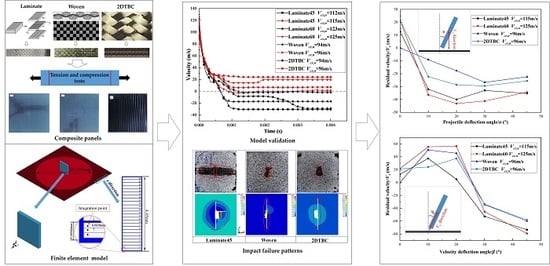Finite Element Study on the Impact Resistance of Laminated and Textile Composites
Abstract
:1. Introduction
2. Materials and Experiments
3. Numerical Model for Impact Simulation
3.1. Subsection Finite Element Model
3.2. Material Model for the Composites
4. Results and Discussion
4.1. Model Validation
4.2. Damage Progression Behavior
4.3. Impact Damage Tolerance of Composite Panels
4.3.1. Effect of Projectile Deflection Angles on Impact Damage
4.3.2. Effect of Velocity Deflection Angles on Impact Damage
4.3.3. Comparison Studies on the Effect of α and β
4.4. Impact Resistance of Different Composite Panels
5. Conclusions
- The finite element model, using shell element with multiple integration points along the thickness, provides good accuracy in predicting the impact threshold of composites panels, and reasonable prediction of failure behavior.
- The laminated composites show better resistance against high-speed ballistic impact, but more serious deformation and larger damage areas, than those of textile composites.
- The impact attitude of the projectile affects the penetrating capability of the projectile. The composite panels are more likely to be penetrated when the velocity deflection angle is 10° < β < 20°.
- The tolerance capability of the composite panels changes moderately when the deflection angles are smaller than 20°, but shows a more obvious sensitivity when the deflection angles go beyond 20°.
- The impact resistance of the composite panels is more sensitive to velocity deflection angle β than against projectile deflection angle α. The textile composites show moderate sensitivity to the deflection angle than the laminate composites.
Author Contributions
Funding
Conflicts of Interest
References
- Roberts, G.D.; Pereira, J.M.; Revilock Jr, D.M.; Binienda, W.K.; Xie, M.; Braley, M. Ballistic Impact of Braided Composites with a Soft Projectile. J. Aerosp. Eng. 2002, 18, 3–7. [Google Scholar] [CrossRef]
- Roberts, G.D.; Revilock, D.M., Jr.; Binienda, W.K.; Nie, W.Z. Impact Testing and Analysis of Composites for Aircraft Engine Fan Cases. J. Aerosp. Eng. 2002, 15, 104–110. [Google Scholar] [CrossRef]
- Ulven, C.; Vaidya, U.K.; Hosur, M.V. Effect of projectile shape during ballistic perforation of VARTM carbon/epoxy composite panels. Compos. Struct. 2003, 61, 143–150. [Google Scholar] [CrossRef]
- Yang, Y.; Zhang, L.; Guo, L.; Zhang, W.; Zhao, J.; Xie, W. Dynamic response and research of 3D braided Carbon Fiber Reinforced Plastics subjected to ballistic impact loading. Compos. Struct. 2018, 206, 578–587. [Google Scholar] [CrossRef]
- Vanderklok, A.; Stamm, A.; Dorer, J.; Hu, E. An experimental investigation into the high velocity impact responses of S2-glass/SC15 epoxy composite panels with a gas gun. Int. J. Impact Eng. 2018, 111, 244–254. [Google Scholar] [CrossRef]
- Liu, L.; Xuan, H.; He, Z.; Niu, D. Containment capability of 2D triaxial braided tape wound composite casing for aero-engine. Polym. Compos. 2016, 37, 2227–2242. [Google Scholar] [CrossRef]
- Liu, L.; Zhao, Z.; Chen, W.; Shuang, C.; Luo, G. An experimental investigation on high velocity impact behavior of hygrothermal aged CFRP composites. Compos. Struct. 2018, 204, 645–657. [Google Scholar] [CrossRef]
- Santos, R.A.M.; Reis, P.N.B.; Silva, F.G.A.; de Mourac, M.F.S.F. Influence of inclined holes on the impact strength of CFRP composites. Compos. Struct. 2017, 172, 130–136. [Google Scholar] [CrossRef]
- Rosso, S.D.; Iannucci, L.; Curtis, P.T. On the Ballistic Impact Response of Micro braid Reinforced Polymer Composites. Compos. Struct. 2015, 7, 70–84. [Google Scholar]
- García-Moreno, I.; Caminero, M.; Rogriguez, G.P.; López-Cela, J.J. Effect of Thermal Ageing on the Impact Damage Resistance and Tolerance of Carbon-Fibre-Reinforced Epoxy Laminates. Polymers 2019, 11, 160. [Google Scholar] [CrossRef]
- Pereira, J.M.; Roberts, G.D.; Ruggeri, C.R.; Gilat, A.; Matrka, T. Experimental Techniques for Evaluat-ing the Effects of Aging on Impact and High Strain Rate Properties of Triaxial Braided Composite; NASA/TM—2010-216763; NTRS: Chicago, IL, USA, 2010.
- Lee, S.W.R.; Sun, C.T. A Quasi-Static Penetration Model for Composite Laminates. J. Compos. Mater. 1993, 27, 251–271. [Google Scholar] [CrossRef]
- Lee, S.W.R.; Sun, C.T. Dynamic penetration of graphite/epoxy laminates impacted by a blunt-ended projectile. Compos. Sci. Technol. 1993, 49, 369–380. [Google Scholar] [CrossRef]
- Sun, C.T.; Potti, S.V. A simple model to predict residual velocities of thick composite laminates subjected to high velocity impact. Int. J. Impact Eng. 1996, 18, 339–353. [Google Scholar] [CrossRef]
- Phadnis, V.A.; Pandya, K.S.; Naik, N.K.; Roy, A. Ballistic impact behaviour of woven fabric composite: Finite element analysis and experiments. J. Phys. Conf. Ser. 2013, 451, 012019. [Google Scholar] [CrossRef] [Green Version]
- Iannucci, L. Progressive failure modelling of woven carbon composite under impact. Int. J. Impact Eng. 2006, 32, 1013–1043. [Google Scholar] [CrossRef]
- Ma, D.; Manes, A.; Amico, S.C.; Giglio, M. Ballistic strain-rate-dependent material modelling of glass-fibre woven composite based on the prediction of a meso-heterogeneous approach. Compos. Struct. 2019, 216, 187–200. [Google Scholar] [CrossRef]
- Muflahi, S.A.; Mohamed, G.; Hallett, S.R. Investigation of delamination modeling capabilities for thin composite structures in LS-DYNA. In Proceedings of the 13th International LS-DYNA Users Conference, Detroit, MI, USA, 8–10 June 2014; pp. 8–10. [Google Scholar]
- Nilakantan, G.; Horner, S.; Halls, V.; Zheng, J. Virtual ballistic impact testing of Kevlar soft armor: Predictive and validated finite element modeling of the V0-V100 probabilistic penetration response. Def. Technol. 2018, 14, 213–225. [Google Scholar] [CrossRef]
- Barauskas, R.; Abraitienė, A. Computational analysis of impact of a bullet against the multilayer fabrics in LS-DYNA. Int. J. Impact Eng. 2007, 34, 1286–1305. [Google Scholar] [CrossRef]
- Kim, C.H.; Sim, H.W.; An, W.J.; Kweon, J.H.; Choi, J.H. Impact characteristics of composite panel stitched by I-fiber process. Compos. Part-A 2019, 127, 660–701. [Google Scholar] [CrossRef]
- Gu, B.; Xu, J. Finite element calculation of 4-step 3-dimensional braided composite under ballistic perforation. Compos. Part-B Eng. 2004, 35, 291–297. [Google Scholar] [CrossRef]
- Tan, H.; Liu, L.; Guan, Y.; Chen, W.; Zhao, Z. A simplified delamination modelling methodology for triaxial braided composites with macro-scale solid finite-element models. Int. J. Crashworthiness 2019, 24, 1–17. [Google Scholar] [CrossRef]
- Liu, L.; Xuan, H.; He, Z.; Niu, D. Containment capability of 2D triaxial braided tape wound composite casing for aero-engine. Polym. Compos. 2016, 37, 2227–2242. [Google Scholar] [CrossRef]
- Omar, A.; Mohamed, E.G. Dynamic and Static Behavior of Hollow-Core FRP-Concrete-Steel and Reinforced Concrete Bridge Columns under Vehicle Collision. Polymers 2016, 8, 432. [Google Scholar]
- Zhao, Z.; Liu, P.; Chen, C.; Zhang, C.; Li, Y. Modeling the transverse tensile and compressive failure behavior of triaxially braided composites. Compos. Sci. Technol. 2019, 172, 96–107. [Google Scholar] [CrossRef]
- ASTM D 3039. Standard Test Method for Tensile Properties of Polymer Matrix Composite Materials; ASTM International: West Conshohocken, PA, USA, 2008. [Google Scholar]
- ASTM D 3410. Standard Test Method for Compressive Properties of Polymer Matrix Composite Materials with Unsupported Gage Section by Shear Loading; ASTM International: West Conshohocken, PA, USA, 2003. [Google Scholar]
- Huang, Z.M.; Liu, L. Assessment of composite failure and ultimate strength without experiment on composite. Acta Mech. Sin. 2014, 30, 569–588. [Google Scholar] [CrossRef]
- Chamis, C.C. Simplified composite micromechanics equations for strength, fracture toughness and environmental effects. Compos. Mater. 1984, 4, 41–45. [Google Scholar]
- Chang, F.K.; Chang, K.Y. A Progressive Damage Model for Laminated Composites Containing Stress Concentrations. J. Compos. Mater. 1987, 21, 834–855. [Google Scholar] [CrossRef]
- Littell, J. The Experimental and Analytical Characterization of the Macromechanical Response for Triaxial Braided Composite Materials. Commun. Math. Phys. 2008, 194, 613–630. [Google Scholar]
- Hallquist, J. LS DYNA Theoretical Manual–Livermore Software Technology; Corporation Livermore: Livermore, CA, USA, 2015. [Google Scholar]
- Hashin, Z. Failure Criteria for Unidirectional Fiber Composites. J. Appl. Mech. 1980, 47, 329–334. [Google Scholar] [CrossRef]
- Feraboli, P.; Wade, B.; Deleo, F.; Rassaian, M. LS-DYNA MAT54 modeling of the axial crushing of a composite tape sinusoidal specimen. Compos. Part-A 2011, 42, 1809–1825. [Google Scholar] [CrossRef]
- Chen, Y.; Santhanagopalan, S.; Babu, V.; Ding, Y. Dynamic mechanical behavior of lithium-ion pouch cells subjected to high-velocity impact. Compos. Struct. 2019, 218, 50–59. [Google Scholar] [CrossRef]
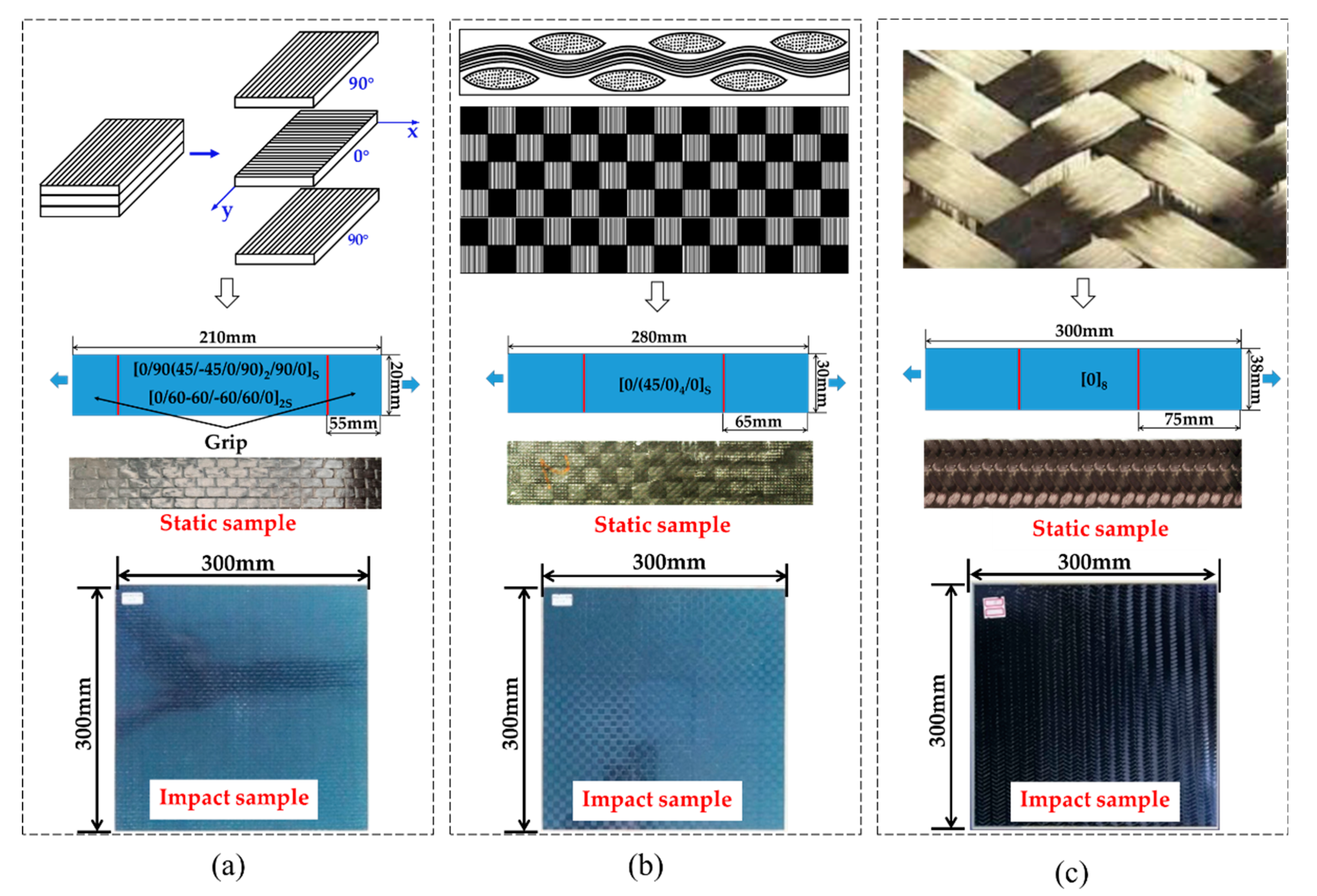
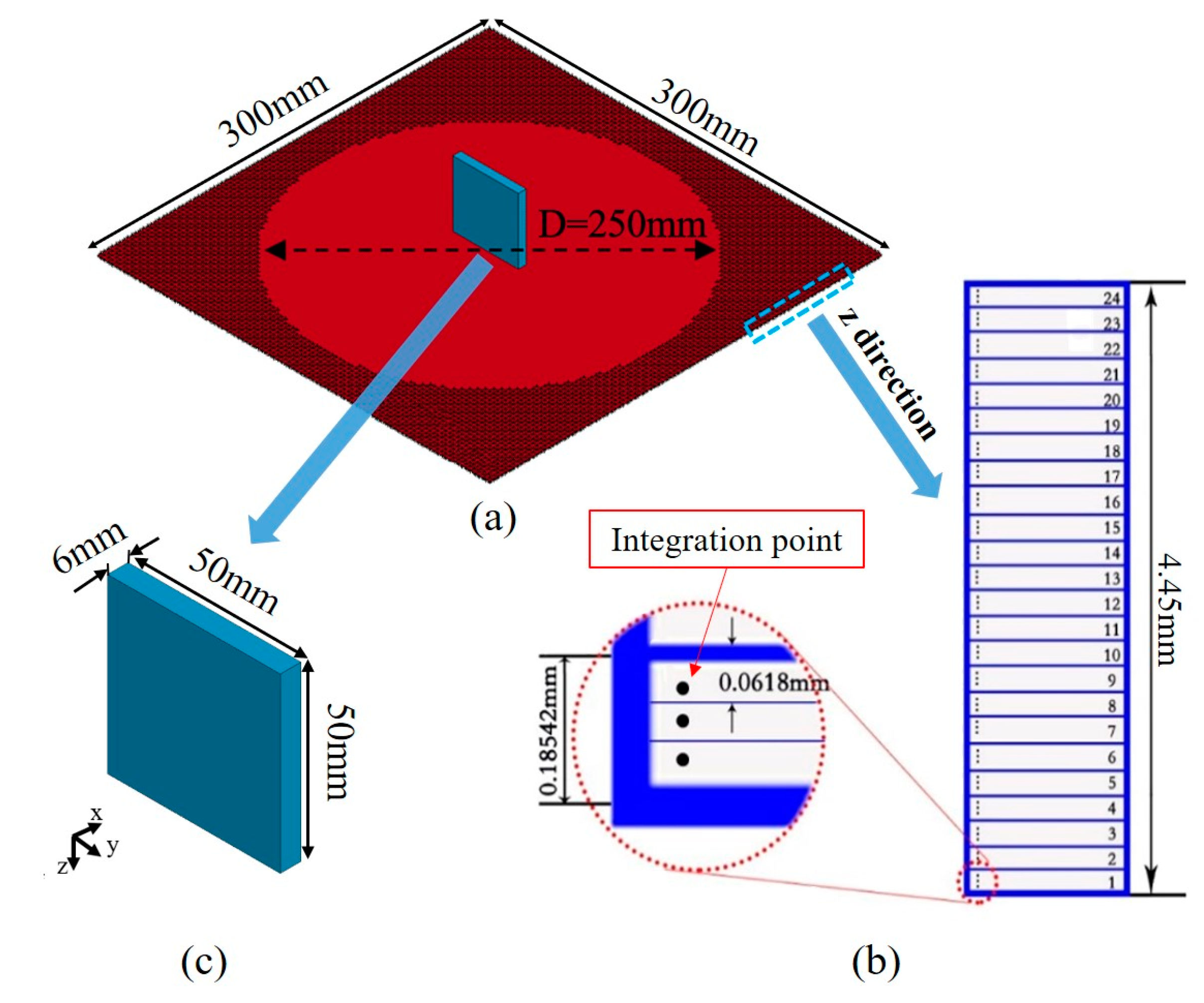

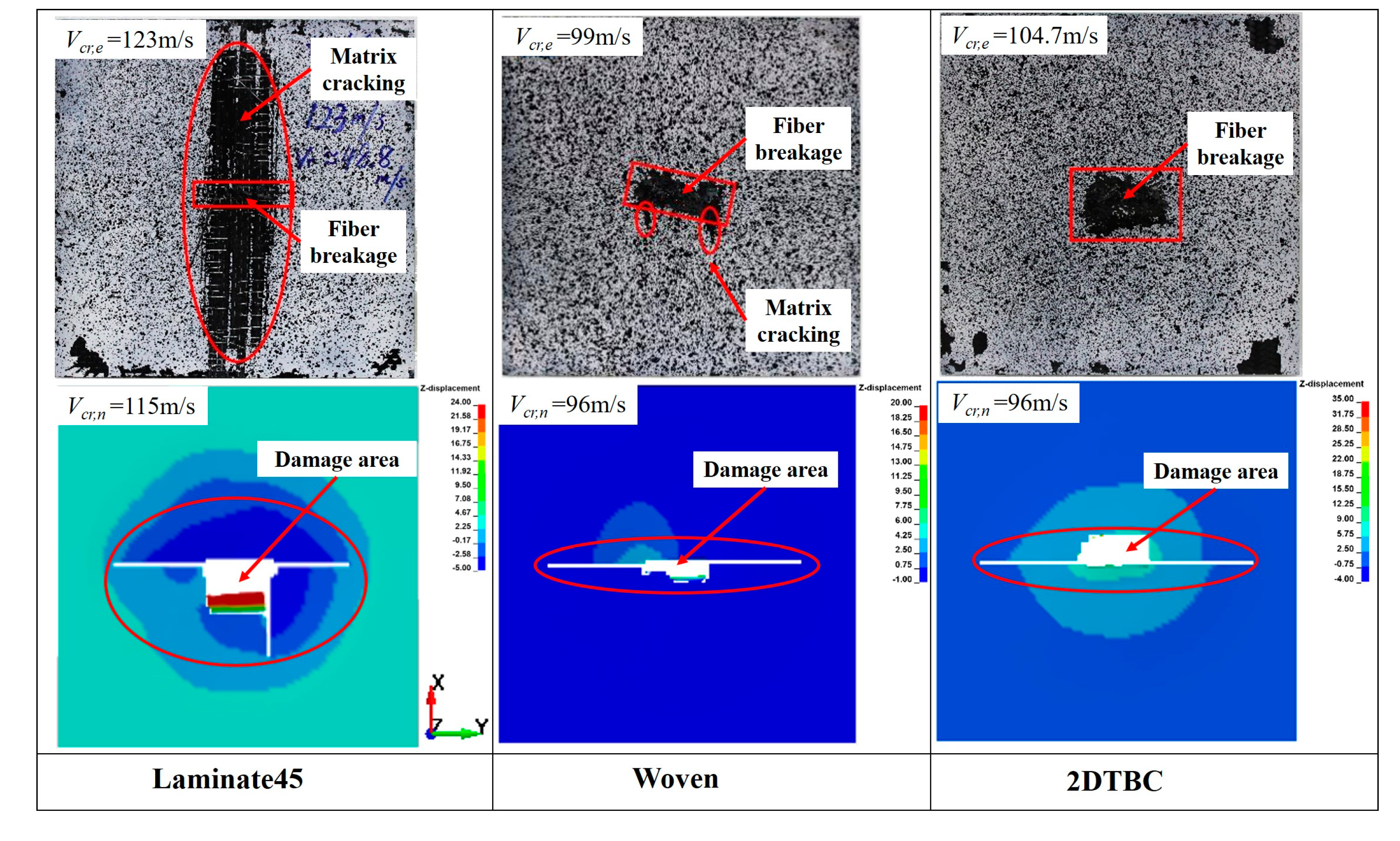
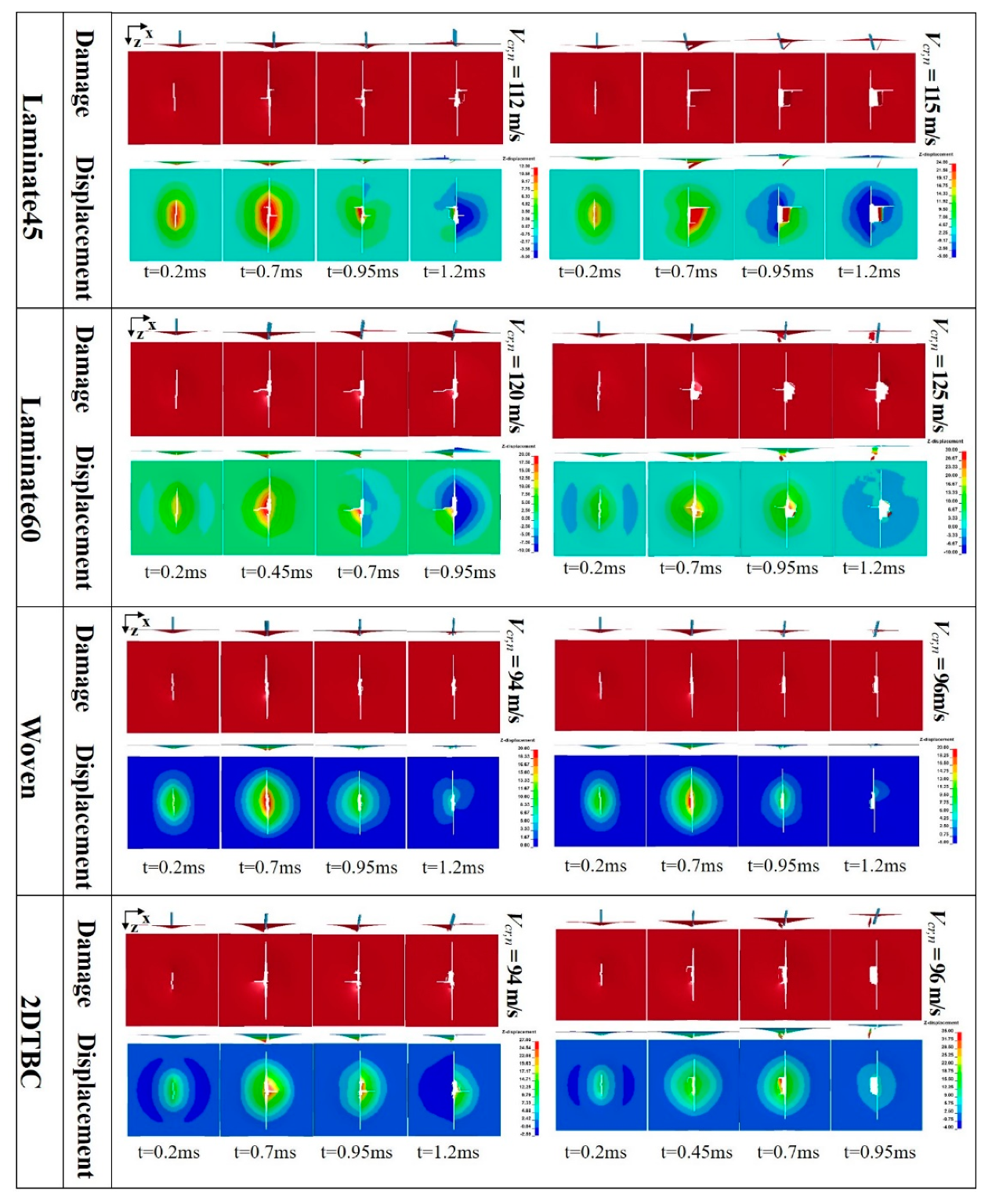
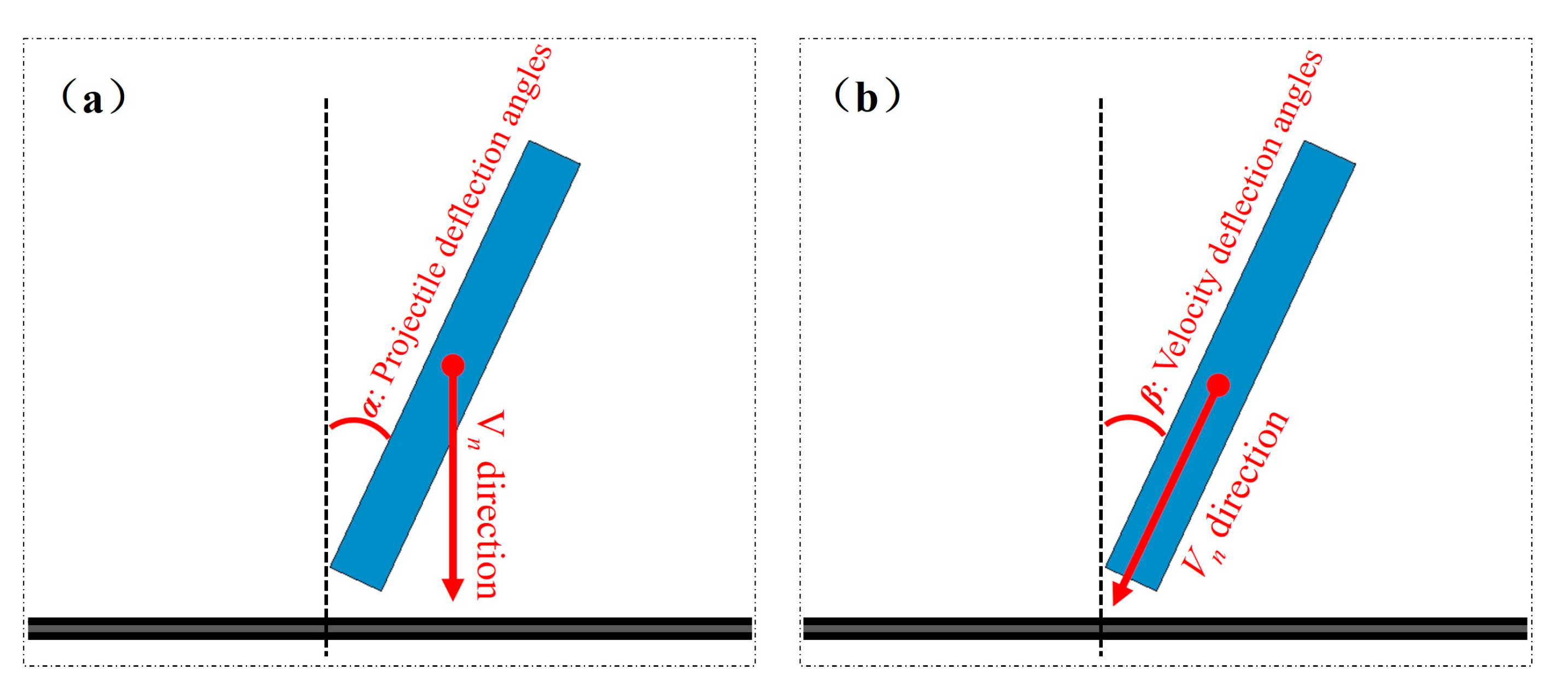
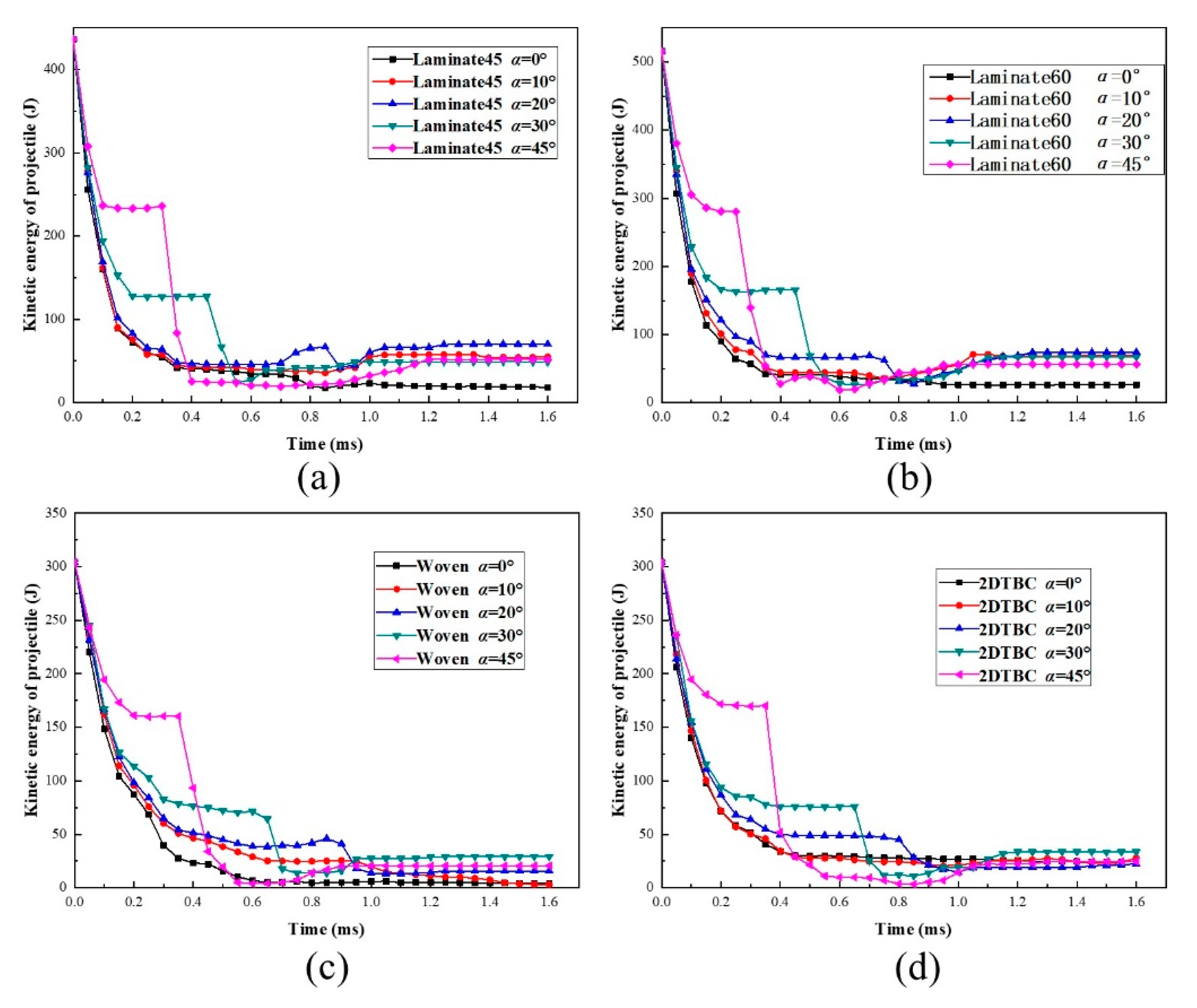
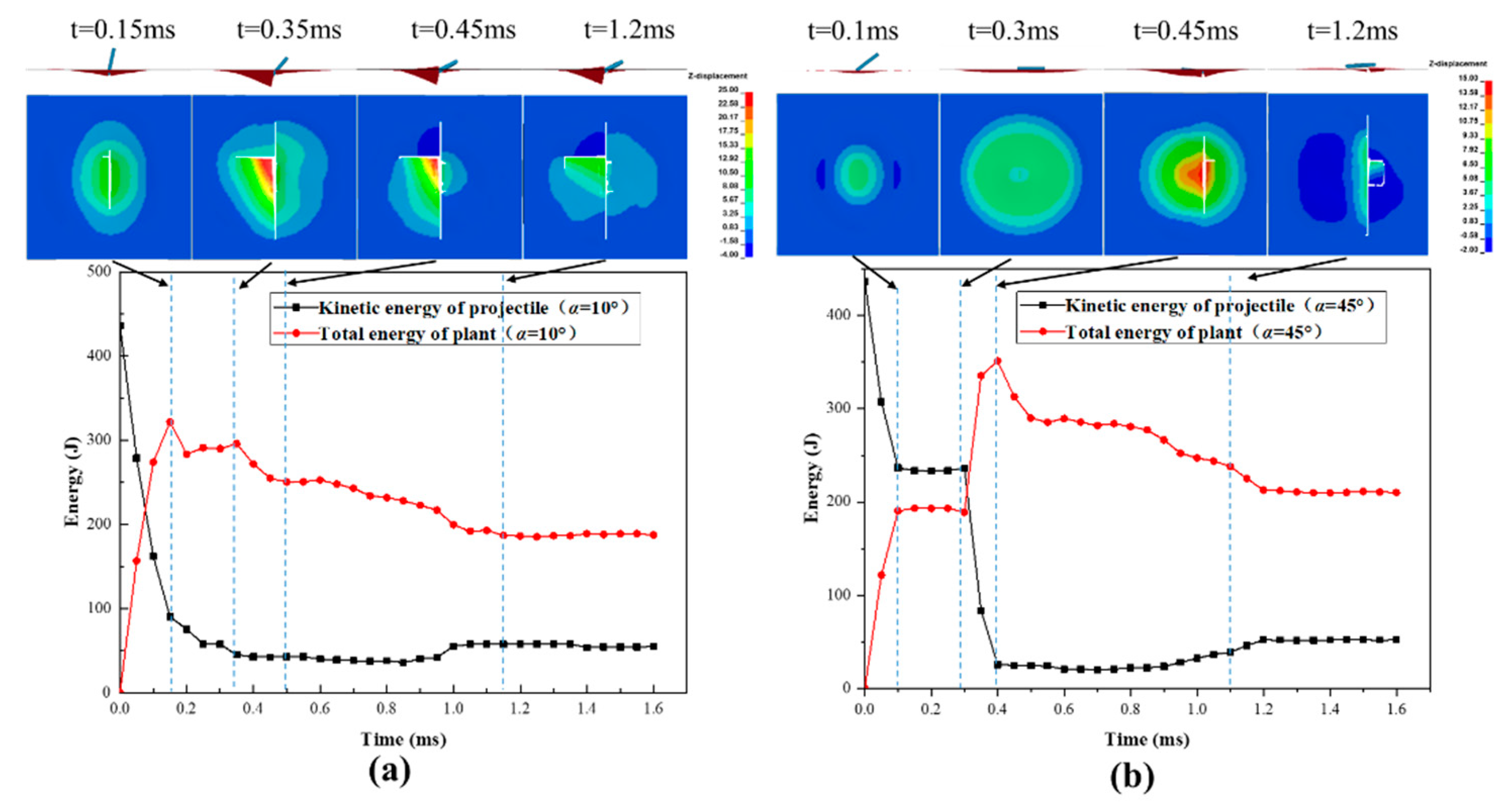
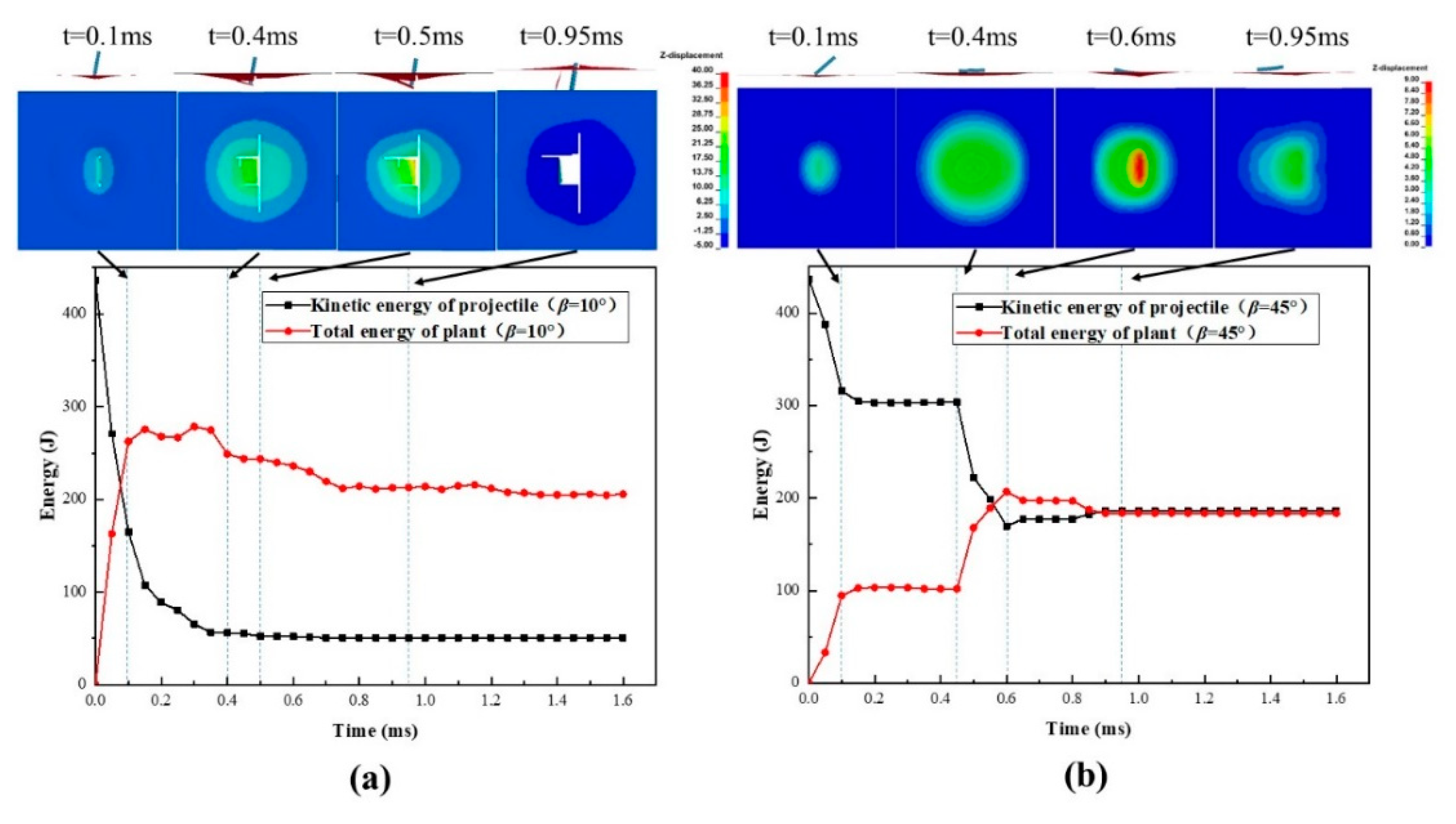
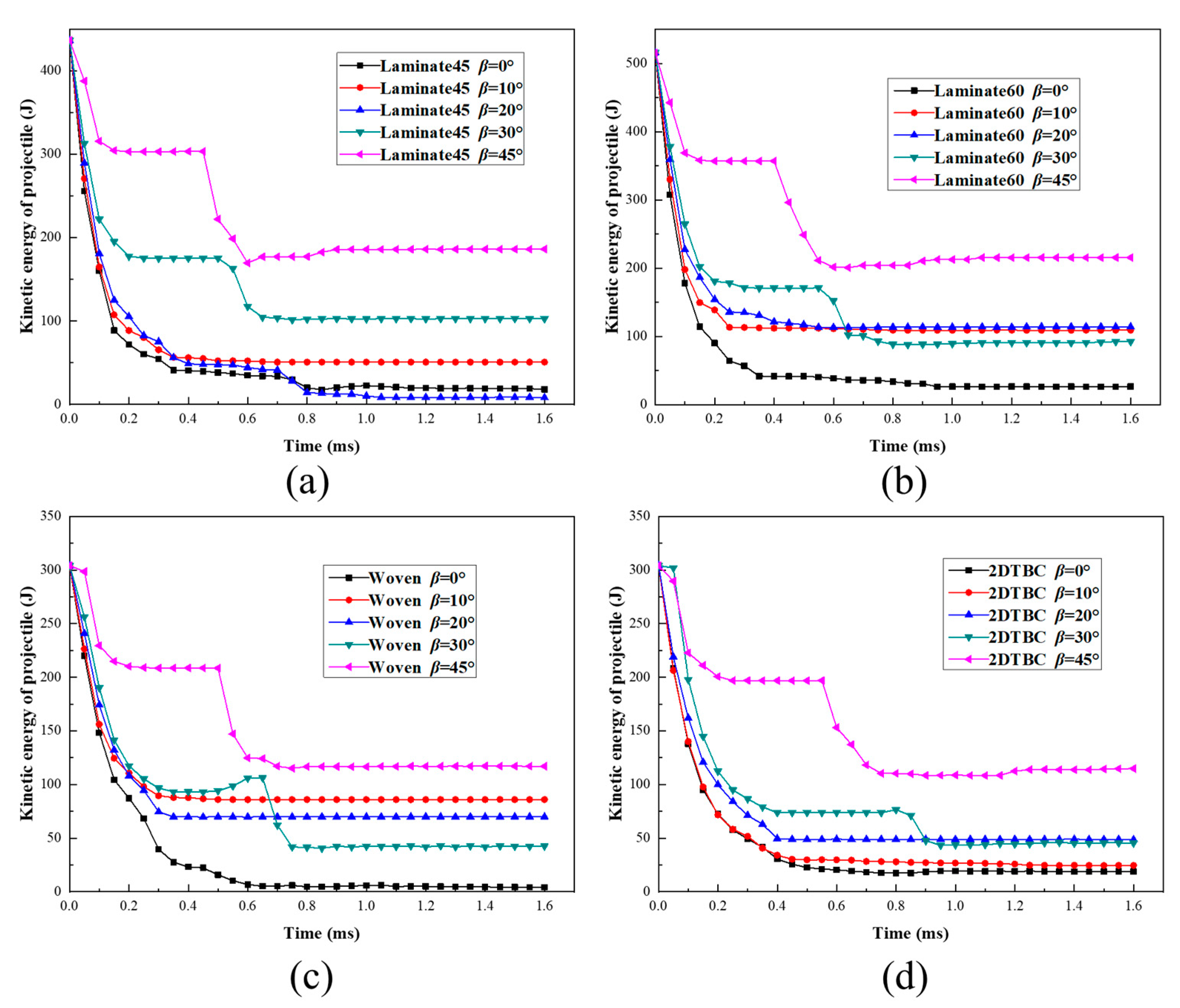
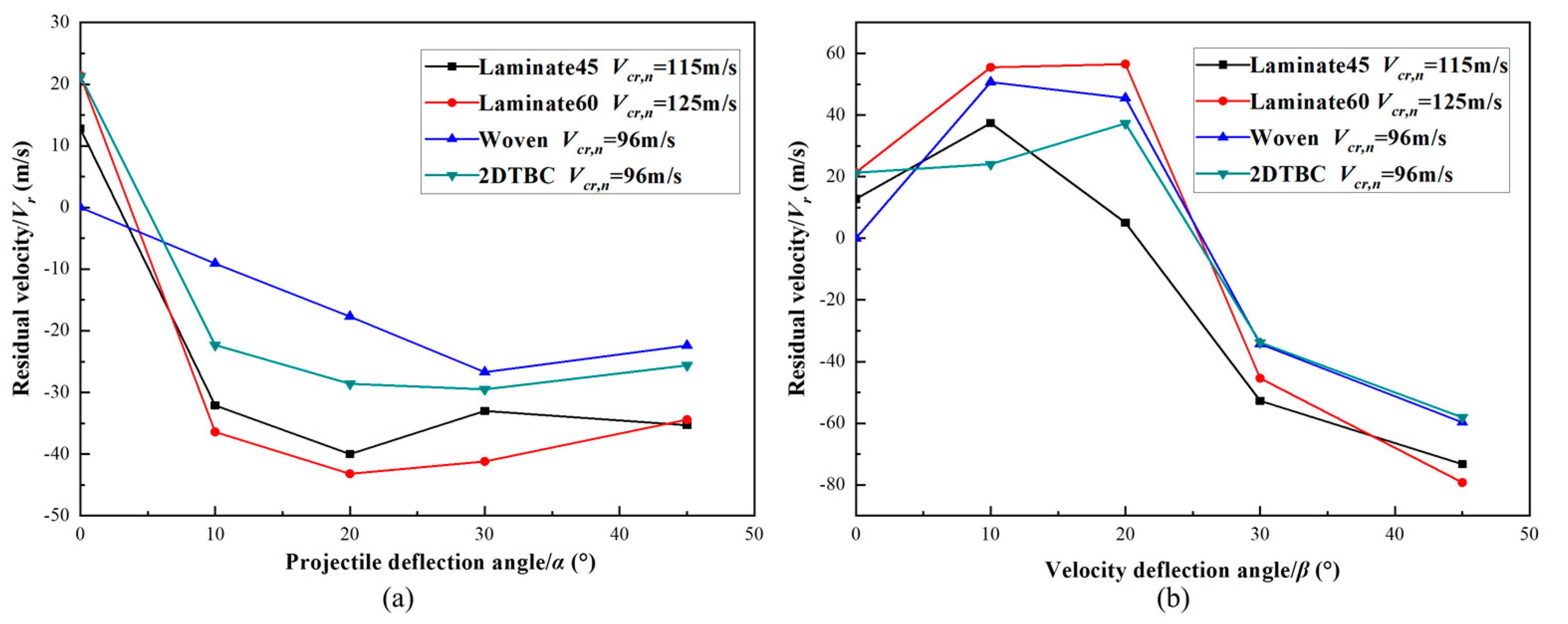
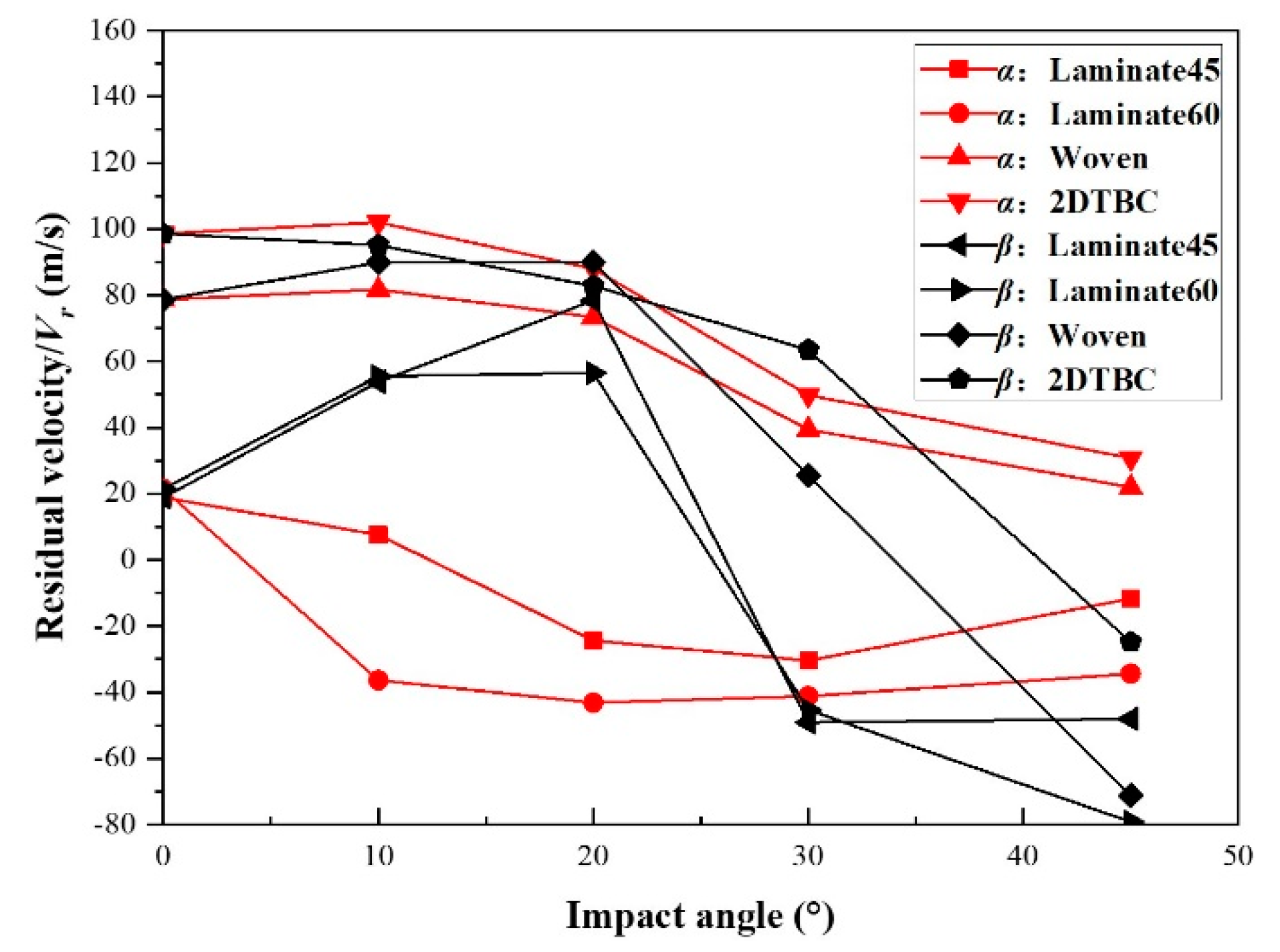
| Laminate45 | Laminate60 | Woven | 2DTBC | |
|---|---|---|---|---|
| Lay-up design | [0/90(45/-45/0/90)2/90/0]S | [0/60-60/-60/60/0]2S | [0/(45/0)4/0]S | [0]8 |
| Thickness(mm) | 4.45 | 4.45 | 3.8 | 4.5 |
| Layers | 24 | 24 | 20 | 8 |
| Number of integration points | 72 | 72 | 60 | 24 |
| Fiber volume ratio | 61.2% | 61.2% | 59.6% | 55% |
| Failure Model | Failure Criterion | Stiffness Degradation Method |
|---|---|---|
| Fiber tensile failure mode | ||
| Fiber compressive failure mode | ||
| Matrix tensile failure mode | ||
| Matrix compressive failure mode |
| Variable | Laminate | Woven | 2DTBC |
|---|---|---|---|
| RO: Mass density/ton × mm−3 | 1.68 × 10−9 | 1.36 × 10−9 | 1.65 × 10−9 |
| EA: Young’s modulus-longitudinal direction/MPa | 139,000 | 55,000 | 44,000 |
| EB: Young’s modulus-transverse direction/MPa | 6655 | 55,000 | 44,000 |
| EC: Young’s modulus-normal direction/MPa | 6655 | 7100 | 7000 |
| PRBA: Poisson’s ratio νba = ν12 | 0.0138 | 0.3500 | 0.3000 |
| PRCA: Poisson’s ratio νca = ν31 | 0.0138 | 0.0331 | 0.0477 |
| PRCB: Poisson’s ratio νcb = ν32 | 0.4450 | 0.0294 | 0.0461 |
| GAB: shear modulus Gab/MPa | 3346 | 5100 | 4000 |
| GBC: shear modulus Gbc/MPa | 3346 | 5100 | 4000 |
| GCA: shear modulus Gca/MPa | 2302 | 4100 | 3200 |
| DFAILT: Max strain for fiber tension | 0.023 | 0.023 | 0.023 |
| DFAILC: Max strain for fiber compression | −0.022 | −0.022 | −0.022 |
| DFAILM: Max strain for matrix straining in tension and compression | 0.042 | 0.042 | 0.042 |
| DFAILS: Max shear strain | 0.032 | 0.032 | 0.032 |
| ALPH: Shear stress non-linear term (ALPH = α) in Equation (3) | 0.85 | 0.85 | 0.85 |
| FBRT: Softening factor for fiber tensile strength after matrix failure | 0.59 | 0.59 | 0.59 |
| YCFAC: Softening factor for fiber compressive strength after matrix failure | 1.2 | 1.2 | 1.2 |
| BETA: Shear stress weighing factor in tensile fiber mode | 0.5 | 0.5 | 0.5 |
| XT: Longitudinal tensile strength Xt/MPa | 2961 | 1051 | 700 |
| XC: Longitudinal compressive strength Xc/MPa | 2665 | 393 | 390 |
| YT: Transverse tensile strength Yt/MPa | 64 | 1051 | 540 |
| YC: Transverse compressive strength Yc/MPa | 127 | 393 | 302 |
| SC: Shear strength S12/MPa | 63 | 120 | 257 [32] |
| Specimen | Experimentally Measured Velocity Threshold | Numerical Predicted Velocity Threshold |
|---|---|---|
| Laminate45 | 117 < Vcr,e < 123 | 112 <Vcr,n < 115 |
| Laminate60 | Vcr,e < 125 | 123 <Vcr,n < 125 |
| Woven | 94 <Vcr,e < 99 | 94 <Vcr,n < 96 |
| 2DTBC | 100.6 < Vcr,e < 104.7 | 94 <Vcr,n < 96 |
© 2019 by the authors. Licensee MDPI, Basel, Switzerland. This article is an open access article distributed under the terms and conditions of the Creative Commons Attribution (CC BY) license (http://creativecommons.org/licenses/by/4.0/).
Share and Cite
Xing, J.; Du, C.; He, X.; Zhao, Z.; Zhang, C.; Li, Y. Finite Element Study on the Impact Resistance of Laminated and Textile Composites. Polymers 2019, 11, 1798. https://doi.org/10.3390/polym11111798
Xing J, Du C, He X, Zhao Z, Zhang C, Li Y. Finite Element Study on the Impact Resistance of Laminated and Textile Composites. Polymers. 2019; 11(11):1798. https://doi.org/10.3390/polym11111798
Chicago/Turabian StyleXing, Jun, Chunlin Du, Xin He, Zhenqiang Zhao, Chao Zhang, and Yulong Li. 2019. "Finite Element Study on the Impact Resistance of Laminated and Textile Composites" Polymers 11, no. 11: 1798. https://doi.org/10.3390/polym11111798






